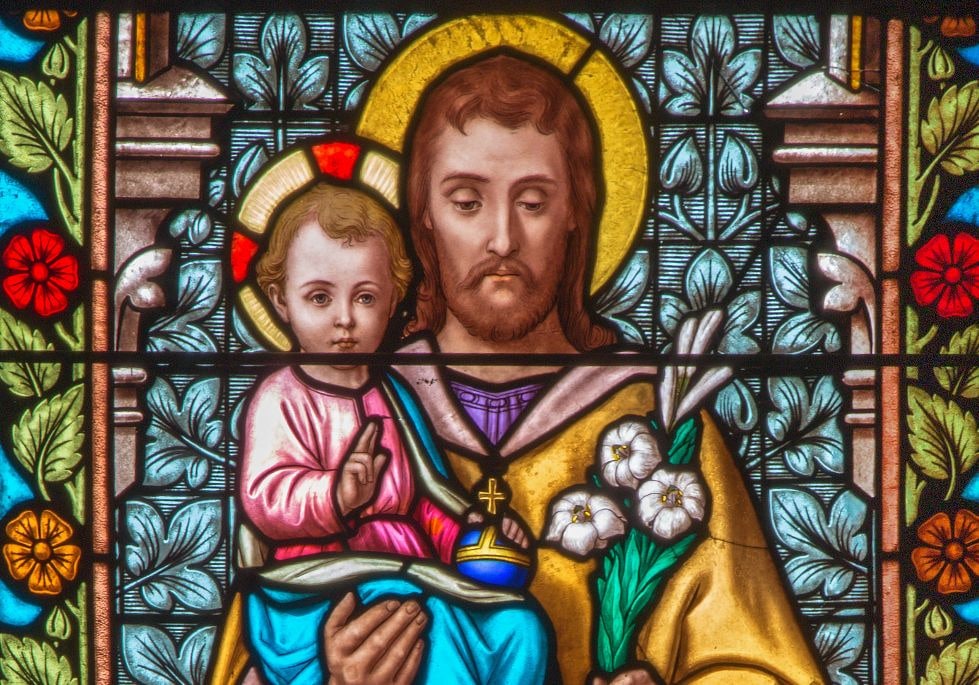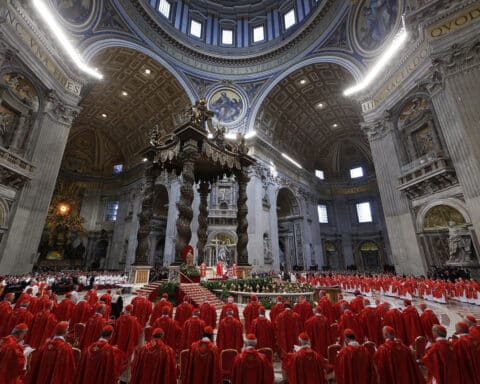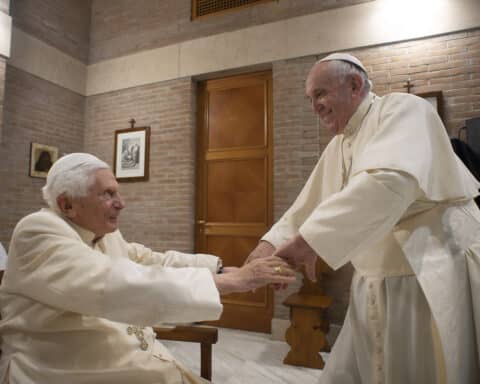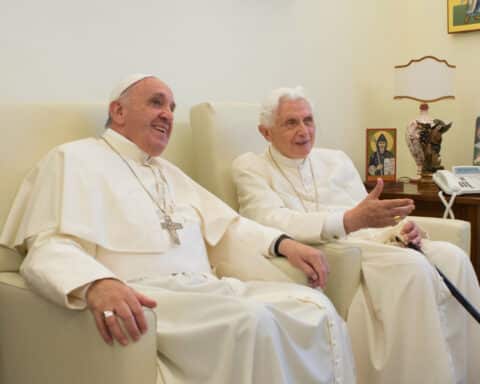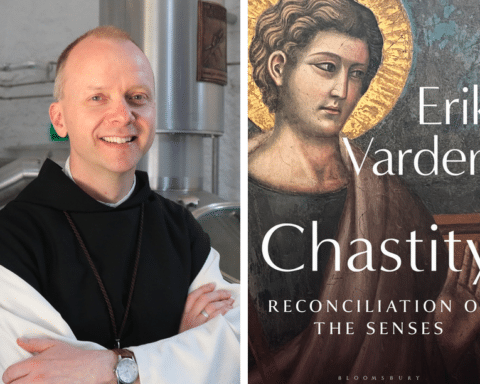Catholics have long been consecrating themselves to the Blessed Virgin Mary, often following the 33-day method in St. Louis de Monfort’s 18th-century spiritual classic “True Devotion to Mary.”
Father Donald Calloway, a Marianist priest, consecrated himself to the mother of Jesus years ago. But in reflecting on some of the challenges facing society in the modern world, Father Calloway told Our Sunday Visitor that he came to realize it was time for a similar consecration to St. Joseph.
“In this time of crisis in fatherhood and marriage, we could really use something about St. Joseph,” said Father Calloway, 47, who lives in Steubenville, Ohio, and serves as the vocations director for the Congregation of Marian Fathers of the Immaculate Conception of the Most Blessed Virgin Mary, a fraternal community of consecrated life.
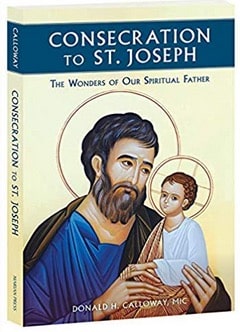
Father Calloway hopes the book will lead many to rediscover the strong, hardworking first-century Jewish man of faith and virtue who provided for Jesus and Mary, and who today is recognized as the patron of the universal Church.
Our Sunday Visitor: Why did you want to write a book about St. Joseph?
Father Donald Calloway: Today, there’s a lot of confusion in the world about some really important things like marriage, family and even what it means to be a man and a woman. There is gender ideology, and people really are confused today about these things. I thought to myself about three years ago that it would be really great if we had some kind of comprehensive program of consecration to St. Joseph, because it would close the gap. We have Marian consecration, which is great. But in this time of crisis in fatherhood and marriage, we could really use something about St. Joseph. That’s when it dawned on me to see if anyone had done it, and when I looked around, nobody had, so I thought, “Well, I might as well do it.” So that’s what I’ve done for the last three years.
Our Sunday Visitor: How did you go about putting together a process of consecration to St. Joseph?
Father Calloway: At first, I didn’t know what to do. It was like, “OK, great idea, but how do I put this in a book form?” Years ago, I had done St. Louis de Monfort’s Marian consecration, and that was just awesome. It’s a 33-day consecration. He’s the one who came up with that method. So I thought, “You know what? I don’t have to reinvent the wheel here. I’ll just use his formula, his template, but I’ll do it for St. Joseph.” So every day you do a little reading and then you say some prayers. You do that for the whole 33 days, and at the end of it, you really get to know the subject matter. It’s really comprehensive. It doesn’t really leave anything out.
Our Sunday Visitor: What kind of work did you do during those three years?
Father Calloway: I gathered all this information from around the world since I travel all the time. I was in Poland, Croatia and South America doing all this research. I had things translated into English for the first time. There’s a lot of great stuff on St. Joseph, but it wasn’t in English. For the book, I also commissioned artwork from eight artists around the world who painted some very unique images of St. Joseph where he’s shown as young, strong, masculine. A lot of the images we have of St. Joseph are pretty lame. That took the artists about a year and a half.
Our Sunday Visitor: What were some of the more interesting things you learned about St. Joseph?
Father Calloway: A lot of awesome stuff. I discovered the ring that St. Joseph gave to the Virgin Mary on their wedding day is still in existence. It’s known as the Santo Anello, “The Holy Ring,” and it’s housed in the cathedral, in a gigantic reliquary, in Perugia, Italy, which is really close to Assisi. And it’s exposed every year for the faithful to venerate. Married couples and those who are engaged are given the privilege of going up and touching their wedding ring to the Santo Anello. That was just mind-blowing to me. And then, the Holy House of Loreto, the home of the Holy Family in Nazareth, which was transported by angels to Italy in the 13th century. It’s been in Loreto, Italy, ever since. It’s one of the greatest relics on the planet, and I have in my book all the saints who visited it and what they said about it. That stuff was just awesome.
Our Sunday Visitor: It’s fair to say that St. Joseph is often overlooked. Why do you think that is?
Father Calloway: I think part of it is that we don’t have one word from him in the New Testament. For him, actions speak louder than words. Unfortunately, in the early Church, there were a lot of false documents circulating about different things associated with the life of the Holy Family. They’re not approved or inspired writings, they’re apocrypha, but they unfortunately set in motion an image of St. Joseph that he was old, widowed from a previous marriage with children. All that stuff is a legend; it’s never been the teaching of the Church, but all that stuff got into art, and people just looked at St. Joseph like, “Well, he’s not really important. He didn’t say anything, and he was old, and was just there as kind of a fill-in.” People didn’t really pay much attention to him. But now, especially in the last 150 years, the Church has done more to promote St. Joseph than in the previous 1,800 years of Christianity. It’s really building, and I think it’s crescendoing now with this movement of consecration to St. Joseph.
Our Sunday Visitor: That he is not even quoted in Scripture, did that make it difficult for you to do research on him?
Father Calloway: When it comes to a primary source, yes. But it wasn’t too difficult, because you can unpack his actions, his obedience, his faith from the things that he did. Even though he didn’t say anything, his actions speak really loudly. And then you can just look at what was required of a first-century Jewish husband and father with the working and the incredible amount of walking. What would have been going on with him when he had to take his family and flee to Egypt and be there for many years? And then you fill it in with what popes have said, with what saints have said, what mystics have said in the Catholic tradition. After a while, you get a really good picture of who this guy was.
Our Sunday Visitor: What is the image like of St. Joseph that began to emerge as you studied his life?
Father Calloway: You get an image of a guy who was not old. If you do the math, he was required by Jewish law to walk to Jerusalem three times a year to fulfill certain rites of the Jewish religion. If he had to do that three times a year, for let’s say 30 years, if you add up the distance, St. Joseph walked around the planet. There’s no way an old man could do this. You had to be young. So as the model of manhood for his son, our Savior, he had to be young and strong. We call him the Model of Workmen, the Pillar of Families, the Glory of Domestic Life, the Terror of Demons — those are not the titles of an old man who’s taking afternoon naps and forgetting things. You get an image of St. Joseph that he was strong, a worker, really in a certain sense the first knight of the Virgin Mary. He’s the first one who called her “My Lady.” He’s the first one to give his life for Jesus and Mary and sacrifice himself. We’re talking about extraordinary holiness here.
Our Sunday Visitor: You’ve mentioned elsewhere that you encountered difficulties in writing this book, even of a supernatural kind. What do you mean by that?
Father Calloway: Some of it, I can’t go into that much, but the devil did not want the book published. There was resistance. The devil was really trying to destroy the book and not let it get into the hands of people, because the devil knows the power St. Joseph has in his intercession with God. There were some really difficult things in trying to get the book published.
Our Sunday Visitor: Was it difficult to organize the book and to write the prayers and reflections?
Father Calloway: At first it was. I had a different format for it when I was coming up with the idea. I spent about six months with this one way of putting the book together until I realized it wasn’t going to work. I prayed about it. I was praying the Litany of St. Joseph when I counted them up and realized the titles of St. Joseph in that litany number about 30, which I thought was perfect. With an introduction, unpacking those titles and a conclusion, I have the 33 days. I made the Litany of St. Joseph the template, so every day we do a little reading on one of those titles, and then we pray the litany. It just worked out perfectly.
Our Sunday Visitor: What are the spiritual fruits of consecrating oneself to St. Joseph?
Father Calloway: The greatest thing is for us to be drawn closer to Jesus through this. Ultimately, it’s all about Jesus, just like Marian consecration helps us to draw closer to Jesus. The second thing would be, if we are spiritual sons and daughters of St. Joseph, all children are called to resemble their parents. He’s not a biological father, of course, but we can resemble him in his virtues. That litany unpacks many of his virtues. He’s patient, he’s courageous, obedient, faithful. So if we want to be like him, we have to imitate him. That’s a key fruit of seeking to imitate him in our lives. Some people have asked, “Can you really consecrate yourself to St. Joseph if you’ve already consecrated yourself to Mary?” Yes. We’re not members of a one-parent spiritual family.
Our Sunday Visitor: What do you think of the reception your book has thus far received?
Father Calloway: It’s only been out two months and we’ve already sold 80,000 copies. It’s in its fifth printing, and it’s already being translated into Spanish, French and Polish. There are also Italian and Arab contracts being looked at. It’s unbelievable. People have written to me and said: “I can’t believe this didn’t exist. Why did it take us so long to recognize his greatness and his dignity and what he means for us in the Church?” Families are doing this. Parishes are doing this. Four bishops in the United States, as a result of this, have decreed years of St. Joseph for their dioceses. My ultimate desire is that the pope would declare a Year of St. Joseph for the universal Church. We’ve never had one, and that would be phenomenal.
Brian Fraga is a contributing editor for Our Sunday Visitor.

